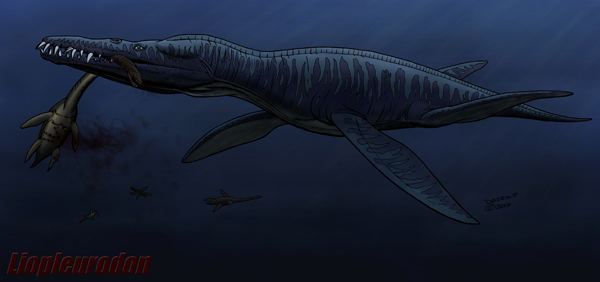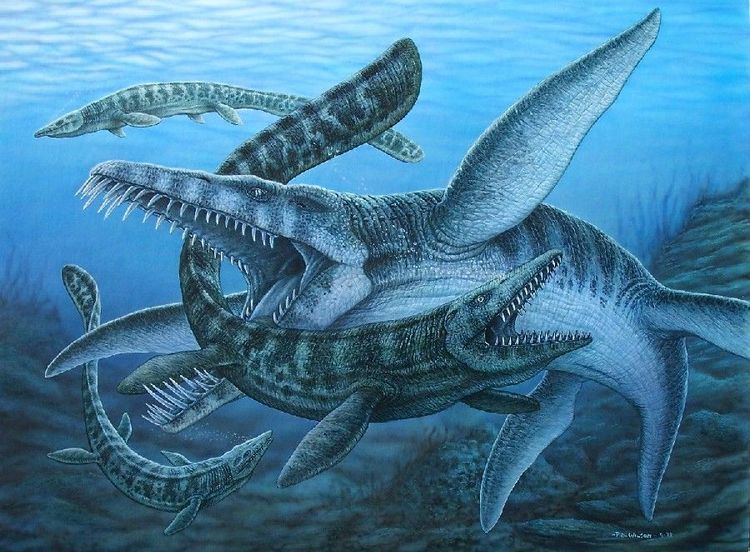Rank Genus | Scientific name Liopleurodon | |
Similar Pliosaurus, Kronosaurus, Pliosauroidea, Plesiosauria, Mosasaurus | ||
Megalodon vs liopleurodon
Liopleurodon (/ˌlaɪOʊˈPlʊərəDɒN/; meaning 'smooth-sided teeth') is a genus of large, carnivorous marine reptile belonging to the Pliosauroidea, a clade of short-necked plesiosaurs. The two species of Liopleurodon lived during the Callovian stage of the Middle Jurassic Period (C. 160 to 155 mya). It was the apex predator of the Middle to Late Jurassic seas that covered Europe. The largest species, L. ferox, is estimated to have grown up to 6.39 metres (21.0 ft) in length.
Contents
- Megalodon vs liopleurodon
- Liopleurodon jurassic sea monster
- Discovery and species
- Palaeobiology
- Size
- Taxonomy
- References

The name "Liopleurodon" (meaning "smooth-sided tooth") derives from Ancient Greek words: λεῖος [leios], "smooth"; pleurá, side or rib; and odṓn, tooth.

Liopleurodon jurassic sea monster
Discovery and species

The genus name Liopleurodon was coined by Henri Émile Sauvage in 1873 on the basis of very poor remains consisting of three 70 millimeter (2¾ inch) teeth. One tooth, found near Boulogne-sur-Mer, France in layers dating from the Callovian, was named Liopleurodon ferox, another from Charly, France was named Liopleurodon grossouvrei, while a third discovered near Caen, France was originally described as Poikilopleuron bucklandi and ascribed by Sauvage to the species Liopleurodon bucklandi. Sauvage did not ascribe the genus to any particular group of reptiles in his descriptions.

Liopleurodon fossils have been found mainly in England and France, with one younger species known from Russia. Fossil specimens that are contemporary (Callovian) with those from England and France referrable to Liopleurodon are known from Germany.

Currently, there are two recognized species within Liopleurodon. From the Callovian of England and France L. ferox is well known; while also from the Callovian of England is the rarer L. pachydeirus, described by Seeley as a Pliosaurus (1869). Only L. ferox is known from more or less complete skeletons.
Palaeobiology

Four strong paddle-like limbs suggest that Liopleurodon was a powerful swimmer. Its four-flipper mode of propulsion is characteristic of all plesiosaurs. A study involving a swimming robot has demonstrated that although this form of propulsion is not especially efficient, it provides very good acceleration - a desirable trait in an ambush predator. Studies of the skull have shown that it could probably scan the water with its nostrils to ascertain the source of certain smells.
Size
Liopleurodon ferox first came to the public attention in 1999 when it was featured in an episode of the BBC television series Walking with Dinosaurs, which depicted it as an enormous 25 m (82 ft) long predator; this was based on very fragmentary remains, and considered to be an exaggeration for Liopleurodon, with the calculations of 20-metre specimens generally considered dubious. The error persisted in the 2003 spin-off Sea Monsters. It is quite likely that someone mistook its length in feet for the size in metres instead.
Estimating the size of pliosaurs is difficult because not much is known of their postcranial anatomy. The palaeontologist L. B. Tarlo suggested that their total body length can be estimated from the length of their skull which he claimed was typically one-seventh of the former measurement, applying this ratio to L. ferox suggests that the largest known specimen was a little over 10 m (33 ft) while a more typical size range would be from 5 to 7 m (16 to 23 ft). The body mass has been estimated at 1 and 1.7 T (2,200 and 3,700 lb) for the lengths 4.8 and 7 m (16 and 23 ft) respectively.
However, new research on Kronosaurus and the finding of a complete skeleton of L. ferox show that their skulls were actually about one-fifth of their total body length, which suggests a maximum known total body length of 6.39 m (21.0 ft) based on NHM R3536, the largest known skull at 1.26 m (4.1 ft) in condylobasal length(1.54 m (5.1 ft) in overall length).
Taxonomy
Liopleurodon belongs to the family Pliosauridae, a clade within Plesiosauria, known from the Jurassic (maybe also from the Cretaceous) of Europe and North America.
Liopleurodon was one of the basal taxa from the Middle Jurassic. Differences between these taxa and their relatives from the Upper Jurassic include alveoli count, smaller skull and smaller body size.
An analysis in 2013 classifies Liopleurodon, Simolestes, Peloneustes, Pliosaurus, Gallardosaurus, and Brachaucheninae as Thalassophonea.
The cladogram below follows a 2011 analysis by paleontologists Hilary F. Ketchum and Roger B. J. Benson, and reduced to genera only.
